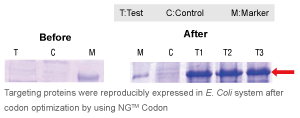Codon optimization is a method referring to the use of preferred codons for a particular organism. The purpose is to avoid the rare codons with low utilization rate in the organism, to adjust the GC content, to simplify mRNA’s secondary structure after gene transcription, and to remove the motif which is not conducive to efficient expression and add the helpful ones. The commercialization of gene synthesis over traditional PCR cloning has greatly promoted the application scope and influence of codon optimization.
By the employment of NG Codon system, Synbio Technologies’ patent pending codon optimization algorithm, complex sequences are optimized efficiently in order to achieve a significantly higher protein expression level. Codon optimization service is complimentary to standard gene synthesis service. The codon optimization platform takes into consideration the below factors:
- Cryptic splice sites
- Poly(N)
- Repeats
- RNA secondary structures
- Killer sequences
- Internal RBS sites
- GC content
Benefits
- Available for any hosts for improving protein expression level: Different organisms have their own preferred codons. For example the preferred termination codons of yeast and mammalian cells are UAA and UGA respectively. Depending on the specific host clients are interested in, codon optimization will be performed for best expression yield in that organism.
- Excellent results for the most challenging sequences: NGTM Codon optimization is capable of optimizing the most complex sequences such as hairpin sequences, highly repeated sequences and extremely long sequences for successful custom synthesis.
- Intellectual property (IP) protection: All of your IP related rights are fully protected by Synbio Technologies. The DNA sequence and its related information are kept strictly confidential during the entire process. All materials and intermediate products including synthesized oligos, genes, plasmids and cells will be destroyed within one month after delivery.
Case Studies
i. Optimization of codons to resemble preferred codon usage for a particular organism
The Y and X axis in the graph below (Figure 1) represent relative usage frequency of codons and the genetic codons respectively. The codon usage (orange bars) is rather dispersed compared to the optimized one (green bars). Synbio technologies has a proprietary NG™ codon optimization algorithm that greatly improves codon usage efficiency and satisfies different customers’ requirements.

Figure 1. Comparison of codon usage frequencies before and after optimization
iI. Improved protein expression level after codon optimization
The target protein was expressed in E.Coli system after codon optimization.

Figure 2. SDS-PAGE results showing target protein expression before and after codon optimization

